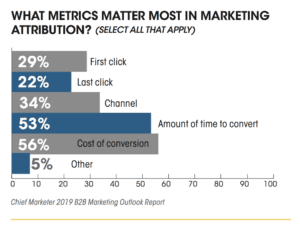 Lengthy sales cycles, numerous touchpoints and too much data are among the biggest hurdles B2B marketers face when it comes to accurate attribution.
Lengthy sales cycles, numerous touchpoints and too much data are among the biggest hurdles B2B marketers face when it comes to accurate attribution.
“Attribution will always be the Holy Grail,” says Kim Weisensee Brown, global marketing leader for GE Renewable Energy and founder of Centrally Human LLC. “I don’t think we’ll ever get to a place of perfect attribution. You need to see what is connected and what isn’t—it’s like trying to map an airplane route while the plane is in the air, and that is challenging.”
In Chief Marketer’s recently released 2019 B2B Marketing Outlook report, respondents lamented that the complexity of their sales cycle made it difficult to determine what was really having an impact.
“We have multiple sources of leads over a long timeline, so no one single source really gets all the credit,” said a respondent. “Understanding what pieces of content helped with conversion is tricky.”
“Easily telling the full attribution story, including what influenced the sale, and justifying channel investments is hard when you look at first and last touch only,” added another, noting the plethora of content platforms and channels is daunting.
“You can get paralyzed by the scope of what you want to do, and end up over analyzing and then have trouble connecting things,” notes Brown.
Related Articles:
- Q&A: Kinney on Guiding the Customer Journey
- Special Report: Chief Marketer 2019 B2B Marketing Outlook
- Q&A: Using Data to Power Human Connections
It can be challenging to figure out which touchpoints are truly moving the needle. Brown notes that one client stopped running display ads for a few weeks, so they could measure the potential list or drop that was seen. “If you turn something off for a few weeks, you can start to see the impact of the channel.”
In our B2B Outlook survey, cost of conversion was cited as the metric that mattered most in attribution, followed by amount of time to convert, channel, first click and last click.
Most people have an overwhelming number of data collection points, notes digital marketing consultant and host of the podcast “A Shark’s Perspective” Kenneth Kinney.
“They think they have good attribution capabilities but they do not. Companies are trying to get away from that last click mentality but they live in siloed environments,” Kinney notes. “You have departments that do their jobs extremely well in their silos, but they’re not using the data to build their personas together. People fumble in the coordination between campaigns because they don’t truly understand where that customer was touched and where they converted. It’s a big problem.”
“Marketing has evolved so much—last touch isn’t the most effective way to gauge success, but neither is first touch,” notes Mike Neumeier, principal of Arketi Group. “There are so many messages out in the marketplace and so many ways to reach your audience. There is so much data accessible to marketers today, but I’m not sure we’re better than we were before.”
“You can’t have a single touch campaign,” adds Euphemia Erikson, vp and head of product marketing at First Data. “We try to look at what is happening at different points in time and see how it all fits together, to see the big picture.”
A recent report from Nielsen found that only 25 percent of marketers have a high level of confidence in their ability to measure the ROI of their media spend. Seventy-nine percent of marketers said they expect to increase their investments in analytics and attribution over the next 12 months.
 Five Killer Tips for Better Marketing Attribution
Five Killer Tips for Better Marketing Attribution
- Map the buyer’s journey. Create a logical pathway for visitors, so you can offer content tailored to unique buyer personas at relevant stages in the sales cycle. Think about your goal, says Jen Spencer, vp-sales and marketing at SmartBug Media. “Start with the end in mind, reverse engineer your marketing campaign, and set up ‘mile markers’ along the way to track trends in your prospects’ digital footprints.”
- Keep the call to action clear. “I’ve always said that the confused buyer always says no,” says Kinney. “If you’re not really giving them a clear and concise message, people get too distracted by other things. You need to know where they are converting and why they are converting. Was it a conversation in a call center or a button on a landing page? If you don’t know what led them in, you can’t optimize.
- Get your sales team involved. In B2B, many of the high-touch relationships exist within the sale team, so it is imperative to get reps to work as marketers and enter data into Salesforce. “You need to digitize this very human pipeline,” says Brown. “It’s a lot of manual work, but if you get sales on board and get them to spend time working with marketing, they will see that it will help them create context with customers in meetings.”
- Have a consistent message for the customer. When leads come in, make sure everything from the first email they see onwards is optimized to engage the prospect, says Kinney. “Do all your landing pages speak the same messages? You may have two or three different agencies working [on a campaign]. Are they coordinating? Are they speaking the right language? You need to make everything about the customer—nothing else you do or say matters.”
- Don’t forget to ask the most important question. “Ask every single customer ‘where did you hear about us?’” says Gordon Brott, senior director of marketing at OnDeck, an online lending company offering financing options to small businesses. “If they just say ‘online,’ don’t take that as an answer. Dig down and you’ll find amazing data that will help you in the long run. “
For more on marketing attribution, lead nurturing trends, martech challenges and insight on where B2B marketers will be investing their budget next year, download our new 2019 B2B Marketing Outlook report.



